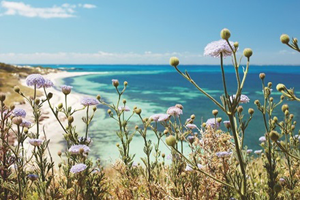DesalData Weekly - December 2, 2015
Posted 02 December, 2015 by Mandy
 On the shores of Rottnest Island in Western Australia, solar energy will soon help to power an existing desalination facility that is undergoing major upgrades. [1] In the spring of 2017, the Rottnest Island Water and Renewable Energy Nexus Project (WREN) will realize its objective to deliver electricity and drinking water for the island at a lower cost and with reduced emissions—by using renewable energy and displacing existing diesel-powered generators. [2] The WREN Project will add 600 kW of solar power to an existing 600 kW wind turbine that was installed in 2004. It will also implement a smart control system that will maximise the use of solar and wind energy when it is most abundant, and store treated water for times when renewable energy is not available. [3]
On the shores of Rottnest Island in Western Australia, solar energy will soon help to power an existing desalination facility that is undergoing major upgrades. [1] In the spring of 2017, the Rottnest Island Water and Renewable Energy Nexus Project (WREN) will realize its objective to deliver electricity and drinking water for the island at a lower cost and with reduced emissions—by using renewable energy and displacing existing diesel-powered generators. [2] The WREN Project will add 600 kW of solar power to an existing 600 kW wind turbine that was installed in 2004. It will also implement a smart control system that will maximise the use of solar and wind energy when it is most abundant, and store treated water for times when renewable energy is not available. [3]
The Rottnest Island Daisy
[1][2][3] Australia’s Renewable Energy Agency is providing this project with approximately $3.5 million USD (A$4.8 million) in funding.
Rottnest Island’s warm weather, sparkling beaches and bays, and diverse flora, marine life, and wildlife attract half a million visitors each year. Archaeologists have revealed that human occupation on the island, known as Wadjemup to Aboriginal Australians, began at least 50,000 years ago. While the island’s flora, fauna, and heritage is protected under the Land Administration Act of 1997, in 2007, community groups and local officials implemented the Marine Management Strategy (MMS) of Rottnest Island—in order to help preserve the island’s marine environment with sanctuary zones, monitoring programmes, research, and education programs.[4] Officials leading the WREN Project hope that their promotion of solar and wind energy will inspire other island communities to relinquish the widespread use of diesel in their water treatment and desalination facilities.[5]
In Lautoka, Fiji, government officials and Pacific utility providers are attending a three-day workshop to discuss the nation’s progress with water desalination and solar projects.[6] The workshop is attended by representatives from Fiji’s Energy Ministry and Water Authority as well as the coordinators of the Pacific Environment Community (PEC) Fund. The PEC Fund itself is a $66 million (¥6.8billion) initiative of the Japanese government to help fund Pacific Island Countries to tackle climate change issues, with focus on the use of solar power generation systems and seawater desalination plants, or a combination of both.[7]
In Chile, the copper mining industry generates more than one-third of the government’s income. In a recent report, the Chilean Copper Commission reports that desalinated water will provide half of the copper industry’s water demand by 2026.[8] The commission’s report, entitled “Projected Water Consumption in 2026 Mining,” forecasts that copper producers’ total freshwater consumption will fall by 19 percent; while, at the same time, seawater consumption will more than quadruple. The report further indicated that desalination will develop in the water-scarce regions of Antofagasta, Atacama, Coquimbo, and Tarapacá. This shift is an important one—as it will help to alleviate the existing stress on limited freshwater sources where mining companies operate.
In Egypt, the government’s Cabinet Economic Committee (CEC) will provide funds to complete works on a seawater desalination plant. The plant is located in Hurghada, the nation’s third largest city, popular with tourists and located on the Red Sea Coast. The government’s financial support, in the amount of US $33,843,762 (EGP 265 million), will enable the plant’s expansion works to increase its production capacity.[9] The CEC has directed the General Authority for Investment to set up associated companies and establishments to help implement these improvements. The committee has also requested the Ministry of Investment to implement certain measures in Egypt’s 27 governorates to attract private investment.
[1] “Australian Island Rigs up Solar Powered Desalination,” November 24, 2015, Desalination & Water Reuse Quarterly, <http://www.desalination.biz/news/news_story.asp?id=8249&title=Australian+island+rigs+up+solar+powered+desalination> accessed December 1, 2015.
[2] “Diesel to ‘de-sal’ on Rottnest Island: Creating Power and Drinking Water with Lower Costs and Emissions,” Hydro, November 18, 2015, <http://www.hydro.com.au/about-us/news/2015-11/diesel-%E2%80%98de-sal%E2%80%99-rottnest-island-creating-power-and-drinking-water-lower-costs-> accessed December 2, 2015.
[3] “Australian Island.”
[4] Marine Management Strategy, Rottnest Island, <http://www.rottnestisland.com/the-island/about-the-island/sustainability> accessed December 2, 2015.
[5] “Diesel to ‘de-sal.’”
[6] Felix Chaudhary, “Pacific Utility Providers Discuss Desalination, Solar Projects,” November 24, 2015, Fiji Times, <http://www.fijitimes.com/story.aspx?id=331182> accessed December 1, 2015.
[7] Pacific Environment Community Fund, Ref#2649, UN Conference on Small Island Developing States, <http://www.sids2014.org/index.php?page=view&type=1006&nr=2649&menu=1507> accessed December 1, 2015.
[8] “Chile's copper mines will turn to desalination for half their water,” November 24, 2015, Desalination & Water Reuse Quarterly, <http://www.desalination.biz/news/news_story.asp?id=8246&title=Chile%27s+copper+mines+will+turn+to+desalination+for+half+their+water> accessed December 1, 2015.
[9] “EGP 265mn to be Provided for Hurghada Desalination Plant,” December 2, 2015, SIS, <http://www.sis.gov.eg/En/Templates/Articles/tmpArticleNews.aspx?ArtID=97861#.Vlwl2s9CqM8> accessed December 2, 2015.
